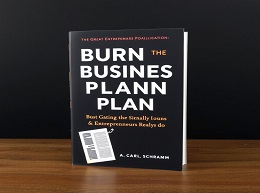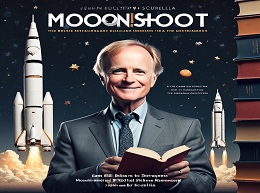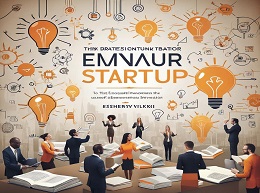Burn the Business Plan: What Great Entrepreneurs Really Do

Rethink Success with "Burn the Business Plan" by Carl Schramm
"Burn the Business Plan: What Great Entrepreneurs Really Do" by Carl J. Schramm is a compelling read that challenges the conventional wisdom of entrepreneurship. Schramm, a distinguished economist and former president of the Kauffman Foundation, presents a persuasive argument against the overreliance on detailed business plans. Instead, he emphasizes the importance of adaptability, action, and leveraging personal networks. This review delves into the key themes of the book, illustrated with real-world examples, to provide a comprehensive understanding of Schramm’s insights for aspiring entrepreneurs.
The Fallacy of Overplanning
Schramm begins by addressing the widespread belief that a meticulously detailed business plan is a critical first step for any successful startup. He argues that this notion is not only misguided but often counterproductive. According to Schramm, many of the world’s most successful entrepreneurs did not rely on rigid business plans.
Example: Steve Jobs and Apple
Steve Jobs and Steve Wozniak started Apple in a garage without a traditional business plan. Their vision and willingness to adapt quickly to market demands allowed Apple to become a tech giant. Jobs’ iterative approach and focus on innovation over planning were crucial to Apple’s success.
Real Drivers of Entrepreneurial Success
The book emphasizes that the real drivers of success are qualities such as adaptability, passion, and a willingness to take risks. Schramm highlights that the entrepreneurial journey is inherently unpredictable, making flexibility a key trait for success.
Example: Airbnb’s Founders
Brian Chesky and Joe Gebbia, the founders of Airbnb, initially offered air mattresses in their apartment to conference attendees. They didn't have a detailed business plan but adapted their idea based on customer feedback. This flexibility transformed Airbnb into a global hospitality platform.
Embrace Action Over Planning
Schramm advocates for focusing on action rather than becoming bogged down in planning. He believes that real-world experience and learning by doing are invaluable for entrepreneurs.
Example: Sara Blakely and Spanx
Sara Blakely, the founder of Spanx, started her company with $5,000 and no formal business plan. By focusing on creating and refining her product based on customer feedback, Blakely built a billion-dollar company through action and adaptation.
Adaptability is Crucial
Entrepreneurs must be willing to pivot and adapt their business models in response to market changes and new opportunities. Schramm underscores the importance of being responsive to the market environment.
Example: Twitter’s Pivot
Originally a podcasting platform called Odeo, Twitter pivoted to a microblogging service after Apple launched its podcasting feature. This strategic shift was driven by the founders’ adaptability and recognition of market trends.
Leveraging Personal Networks
Schramm highlights the value of personal networks in entrepreneurship. Connections with mentors, industry experts, and fellow entrepreneurs can provide critical support and opportunities.
Example: LinkedIn’s Early Growth
Reid Hoffman, co-founder of LinkedIn, used his extensive network in Silicon Valley to build the platform. His connections helped secure early investments and attract influential users, driving LinkedIn’s initial growth.
Learning from Failure
Failure is an integral part of the entrepreneurial process. Schramm encourages entrepreneurs to view failures as learning experiences rather than setbacks.
Example: Thomas Edison’s Resilience
Thomas Edison’s path to inventing the incandescent light bulb was marked by numerous failures. Each unsuccessful attempt taught him valuable lessons, ultimately leading to his success. Edison’s resilience and learning from failure are essential traits for any entrepreneur.
Embrace Experimentation
Schramm advocates for a culture of experimentation within startups. Entrepreneurs should test their ideas quickly and cheaply to validate assumptions and make informed decisions.
Example: Dropbox’s MVP Strategy
Drew Houston, founder of Dropbox, used a minimum viable product (MVP) strategy by creating a simple demo video of Dropbox. The positive response validated his idea before significant investment in development, demonstrating the power of quick, low-cost experimentation.
Build a Strong Team
A complementary team is crucial for startup success. Schramm advises entrepreneurs to surround themselves with talented individuals who share their vision and contribute diverse skills.
Example: Google’s Founding Team
Larry Page and Sergey Brin, the co-founders of Google, complemented each other’s skills and collaborated effectively. The recruitment of key team members like Eric Schmidt was instrumental in Google’s growth, showcasing the importance of a strong team.
Financial Prudence
Entrepreneurs should be prudent with their finances, avoiding excessive spending and maintaining a lean operation until the business becomes sustainable.
Example: Mailchimp’s Bootstrap Approach
Ben Chestnut and Dan Kurzius, founders of Mailchimp, bootstrapped their company without external funding. This financial discipline allowed them to grow sustainably and retain full control over their business.
Customer-Centric Approach
Understanding and prioritizing customer needs is essential. Schramm emphasizes that successful entrepreneurs are obsessed with solving real problems for their customers.
Example: Zappos’ Customer Service
Tony Hsieh, CEO of Zappos, built the company with a relentless focus on customer service. This commitment to exceeding customer expectations helped build a loyal customer base and a strong brand reputation.
A New Paradigm for Entrepreneurs
"Burn the Business Plan" offers a refreshing perspective on entrepreneurship, debunking traditional myths and providing actionable insights. Schramm’s emphasis on adaptability, action, personal networks, and learning from failure resonates with the realities of building a successful business.













